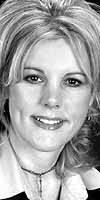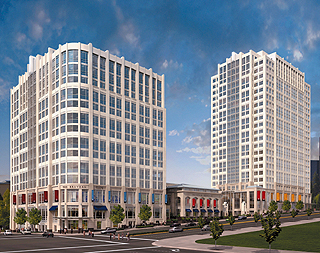
Surveys
DJC.COM
December 15, 2005
Lifestyle centers: A return to Main Street USA?
Seattle Pacific Realty

Best
|
Lifestyle centers attract retailers that are willing to pay higher rents, which also covers the cost of more dazzling design and expensive development fees. The concept is also a sweetheart to cities that are looking to upgrade and revitalize their city core or tired neighborhoods that lost shoppers to the malls.
But, sentiments are beginning to grow amongst the retail community that there is now a blur between whether a project is really a lifestyle center and what the meaning of a lifestyle center really implies.

Image by Bowen Studios
The Bravern in Bellevue will be a multilevel lifestyle center when it opens in 2008.
|
What is a lifestyle center?
Poag & McEwen Lifestyle Center of Memphis, Tenn. — a specialist in developing, leasing and managing lifestyle centers — coined the term lifestyle centers. The company defines lifestyle centers as "easily accessible, allowing visitors to park near the storefront and walk right in." They are built on a human scale and designed to "promote a sense of shelter, safety and belonging."
Poag and McEwen further says "lifestyle centers are also places of beauty with fountains and green spaces. More importantly, they give retailers the ability to more conveniently serve their specific demographic away from the usual crush of dollar store and superstore customers."
The most popular local example of the market shift to a lifestyle center is University Village. Although the project has become a hybrid of regional strip and lifestyle center elements sprinkled with traditional mall tenants, the stores work together to create not just a shopping experience but also a social experience. The outdoor setting has matched in-demand retail stores and restaurants that supply a well-blended entertainment and shopping experience. The stores and restaurants also offer close proximity to urban-style housing and provide defined urban-style storefronts with curb side, sidewalk and storefront exposure.
Local tenants wanted
Melanie Corey-Ferrini, founder of Dynamik, a Seattle branding and architecture firm, spells out the formula for a lifestyle center on a local level.
"Centers are looking for well-known national tenants, along with that unique local boutique tenant — adding local character and merchandising," Corey-Ferrini said. "Different than a regional mall, a lifestyle center must have these local tenants woven into their overall tenant mix fabric. You also see this in a tenant's positioning of their brand where we are planning more local elements and vignettes into the store as backdrops to their core/base merchandise use throughout the country. Signage and urban storefront design and materials will become more and more important in order to differentiate and position one center from another."
Rick Parks, vice president of leasing for TRF Development, adds that a lifestyle center "provides a mix of luxury retailers that is generally recognized for appealing to an affluent customer base, with an income above $85,000 average income, who live above or within close proximity."
City-friendly
Once anti-development, cities are now supporting the lifestyle center sizzle to revitalize dead space or dying retail areas.
Multilevel downtown retail is making a comeback as the lifestyle centers go vertical. Most notable is The Bravern project, being developed in downtown Bellevue by Schnitzer Northwest with a projected 2008 opening. The Bravern is planned to take Bellevue from a 12-hour to an 18-hour experience.
"The Bellevue customer has been asking for the downtown core to offer a project that is committed to a venue of luxury retailers and unique restaurants that carry a quality entertainment component," said Dan Ivanoff, managing investment partner of Schnitzer Northwest. "We are committed to not short-change them and fall short of their expectations. It will be a place just to be, a place where people go to shop, not just to buy like at our regional malls."
In European cities that mixed-use and lifestyle centers are often modeled after, not only is the synergy of the tenant mix important, so is the location of the project within the context of its city. We are seeing cities planning themselves in a way that zoned lifestyle centers can easily be placed in strategic locations to support the urban lifestyle idea.
As sites become denser, we are becoming more reliant on good transportation systems to support the lifestyle concept. People are more open to living in smaller homes or condos, closer to an urban experience, which further supports this idea and possibly even more integration of housing into the centers as we move forward.
It seems in some ways that we have come back to that Main Street USA concept — only a more defined and orchestrated experience for the 21st century.
Elizabeth S. Best, senior retail specialist for Seattle Pacific Realty, has over 15 years of marketing, sales, leasing, public relations and promotional experience in commercial real estate.
Other Stories:
- Richard Lee
- 8 questions office tenants should be asking
- It's time for housing in downtown Olympia
- Visionary property owners try some new tools
- Pullman developer's mantra: Learn from your mistakes
- Making today's mixed-use projects work
- How do lease options work?
- Resurrecting the Technology Corridor
- Will hurricanes puff up insurance rates here?
- How Trammell Crow hit the real estate jackpot
- How rising interest rates will affect real estate
- Is it safe to jump back into the condo market?
- CBA is bullish on the commercial market
- Arthur Rubinfeld
- Bill Morton
- Here's what's in store for retail properties
Copyright ©2009 Seattle Daily Journal and DJC.COM.
Comments? Questions? Contact us.